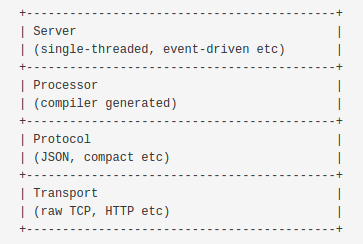thrift分层结构解析
thrift
thrift分层结构

Transport层
Transport层提供了一个从网络中简单的抽象化的读写操作。这样使得thrift能将底层传输和其他部分解耦(如:序列化/反序列化)
以下是Transport接口:
- open
- close
- read
- write
- flush
除了上面的Transport接口,thrift还使用ServerTransport接口来接受和创建原始传输对象。顾名思义,ServerTransport主要用于服务端,通过传入一个连接来创建新的传输对象。其主要方法有:
- open
- listen
- accept
- close
以下是Thrift支持语言中的一些可用的传输:
- file: read/write to/from a file on disk
- http: 顾名思义
Protocol层
Protocol抽象化的定义了一种将内存数据接口映射到一种线型格式的机制。换句话说,一个Protocol指定了数据类型如何使用底层Transport来对自身进行编码/解码。因此Protocol实现了控制编码方案及负责(反)序列化。这种意义上的协议的一些实例包括JSON,XML,纯文本,compact binary(紧凑型二进制)。
以下是Protocol接口:
- writeMessageBegin(name, type, seq)
- writeMessageEnd()
- writeStructBegin(name)
- writeStructEnd()
- writeFieldBegin(name, type, id)
- writeFieldEnd()
- writeFieldStop()
- writeMapBegin(ktype, vtype, size)
- writeMapEnd()
- writeListBegin(etype, size)
- writeListEnd()
- writeSetBegin(etype, size)
- writeSetEnd()
- writeBool(bool)
- writeByte(byte)
- writeI16(i16)
- writeI32(i32)
- writeI64(i64)
- writeDouble(double)
- writeString(string)
- name, type, seq = readMessageBegin()
- name, type, seq = readMessageEnd()
- name = readStructBegin()
- name = readStructEnd()
- name, type, id = readFieldBegin()
- name, type, id = readFieldEnd()
- k, v, size = readMapBegin()
- k, v, size = readMapEnd()
- etype, size = readListBegin()
- etype, size = readListEnd()
- etype, size = readSetBegin()
- etype, size = readSetEnd()
- bool = readBool()
- byte = readByte()
- i16 = readI16()
- i32 = readI32()
- i64 = readI64()
- double = readDouble()
- string = readString()
Thrift Protocols 是面向流的设计。这里不需要任何明确的框架。例如,在开始序列化之前,它没必要知道一个字符串的长度或者list中元素的数量。Thrift支持的大多数语言可用的一些协议有: * binary:相当于简单的二进制编码–字段的长度和类型被编码为字节,后跟字段的实际值。(Fairly simple binary encoding – the length and type of a field are encoded as bytes followed by the actual value of the field.) * compact:参考 THRIFT-110 * json
Processor层
一个Processor封装了从输入流读取数据和写入数据到输出流的能力。这些输入流和输出流由Protocol对象表示。Processor接口非常的简单
interface TProcessor {
bool process(TProtocol in, TProtocol out) throws TException
}
服务特定的Processor由编译器生成。Processor实质上是从线路中读取数据(使用输入协议),将处理委托给处理程序(handler,由用户实现),并且通过线路写入响应中(使用输出协议)。
Server层
一个Server(服务)聚集了上述所有的功能:
- 创建一个Transport
- 从Transport中创建输入/输出Protocols
- 基于输入/输出协议(Protocol)创建一个处理器(Processor)
- 等待传入连接并且交给处理器(Processor)
